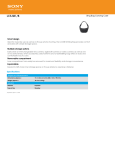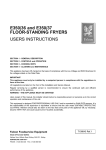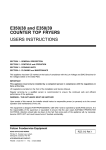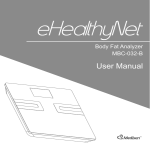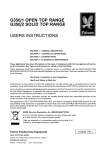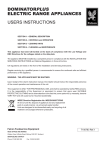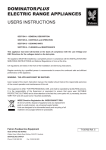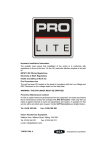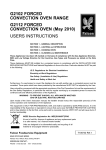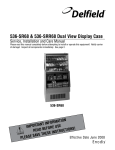Download CHIEFTAIN HEAVY DUTY ELECTRIC APPLIANCES
Transcript
CHIEFTAIN HEAVY DUTY ELECTRIC APPLIANCES USERS INSTRUCTIONS SECTION 1 - GENERAL DESCRIPTION SECTION 2 - CONTROLS and OPERATION SECTION 3 - COOKING HINTS SECTION 4 - CLEANING and MAINTENANCE This appliance has been CE-marked on the basis of compliance with the Low Voltage and EMC Directives for the voltages stated on the Data Plate. IMPORTANT This appliance must only be installed by a competent person in compliance with the regulations in force at the time. UK regulations are listed on the front of the Installation and Service Manual. Regular servicing by a qualified person is recommended to ensure the continued safe and efficient performance of the appliance. WARNING - THIS APPLIANCE MUST BE EARTHED! Upon receipt of this manual, the installer should instruct a responsible person (or persons) as to the correct operation and maintenance of the unit. This equipment is designed FOR PROFESSIONAL USE ONLY and be operated by QUALIFIED persons. It is the responsibility of the supervisor or equivalent to ensure that the user wears SUITABLE PROTECTIVE CLOTHING. Attention should also be drawn to the fact that some parts of the appliance will, by necessity, become VERY HOT and could cause burns if touched accidentally. Falcon Foodservice Equipment HEAD OFFICE AND WORKS Wallace View, Hillfoots Road, Stirling. FK9 5PY. Scotland. AFE SERVICELINE CONTACT PHONE - 01438 363 000 FAX - 01438 369 900 T100525 Ref. 1 SECTION 1 - GENERAL DESCRIPTION This manual covers the operation of the following units. These are Chieftain Heavy duty appliances. If for any reason it is considered necessary to maintain a hotplate hot when not being used, turn the control to a low setting, say 2 or 3. The hob is constructed of cast iron. The hotplates are controlled by six position rotary switches. The oven has a cubic capacity of 4.8ft3 (gross)/ 3.8ft3 (nett) with a drop down door. Two non-tilt shelves are included which will accomodate two 1/1 size gastronorm containers per shelf. All appliances are mounted on adjustable feet with shrouds. The oven is controlled by means of a thermostat, located at the top of the RH control panel. There are two neons, RED indicates that the mains electricity to the unit is ON and AMBER illuminates when the thermostat is switched on and the oven is heating up. When the oven is at the selected temperature the AMBER light will go out. The oven temperature is automatically controlled by the thermostat so that after a dish has been cooked satisfactorily it may be repeated with confidence. The cooking chart gives basic temperatures and times required. For best performances the following instructions should be carried out - E1006 Range with Three Solid Hotplates E1016 General Purpose Oven (Single Tier) E1016/2 General Purpose Oven (Double Tier) E1026 Boiling Table with Three Solid Hotplates SECTION 2 - CONTROLS and OPERATION Hotplate The hotplate arrangement consists of three rectangular hotplates, each controlled by a six-heat switch. This controls variable temperatures from 1 (the lowest) progressively increasing to 6 (the highest). The neons at the top of the control panel indicate which hotplate is ON. The requisite setting for simmering pots of various sizes will quickly be found by experience. For efficient operation of the hotplates it is essential that there should be intimate contact between the hotplate and the utensil. Ground base pans should be used and the plate surface should be clean and in good condition. Spillage should not be allowed to accumulate around the edges of the hotplates. It will burn on and become difficult to remove. There is a pull out spillage tray beneath the hotplates and this is readily withdrawn for emptying and cleaning when the unit is cool. Important Oven Control Situated on unit RH side Hotplate Controls Situated below the hob To ensure long life of the hotplates and to conserve electricity, DO NOT LEAVE THE H O T P L A T E S SWITCHED ON WHEN NOT IN USE, particularly at high settings. Oven Shelves Two oven shelves are supplied. There are four shelf positions in the oven. If both shelves are being used at once, these should be positioned with at least one shelf space left between them (i.e. top and second bottom or second top and bottom). Always push the shelves right to the back of the oven. Tray Size The full area of each shelf may be used for cooking. Smaller trays or dishes can be placed centrally on the shelves. Gastronorm trays 650mm x 530mm can be fitted between the runners without the need to use the shelves. Pre-heat Time Allow at least one hour from having lit the oven cold before commencing loading. Put the food in quickly and close the doors firmly. DO NOT leave the oven doors open for prolonged periods while the oven is switched ON. Getting the best use out of this type of unit is largely a matter of experience, coupled with the needs of the particular task in hand. It is not possible to provide detailed instructions for cooking any particular dish but obviously the temperature of the plate must be regulated for different needs. SECTION 3 - COOKING HINTS Notes 1. High temperature (quick) roasting These times reflect average requirements. The quality and shape of meat and personal tastes will effect the time requried. 2. Low temperature (slow) roasting These items require longer cooking times but reduce weight loss and achieves more even cooking. This method is preferable for tougher joints and old poultry. QUICK SLOW ROASTING ROASTING MEAT TYPE BEEF 15 minutes per 20 minutes per (on the bone) 0.5kg (1lb) 0.5kg (1lb) BEEF 20 minutes per 30 minutes per (no bones) 0.5kg (1lb) 0.5kg (1lb) MUTTON, 20 minutes per 30 minutes per LAMB 0.5kg (1lb) 0.5kg (1lb) VEAL, 25 minutes per 35 minutes per PORK 0.5kg (1lb) 0.5kg (1lb) For joints up to 2.7kg (6lbs) in weight add a further 20 minutes to these times CHICKEN, 15 minutes per 20 minutes per TURKEY, DUCK 0.5kg (1lb) + 15 0.5kg (1lb) + 15 3. Small Cakes, Scones etc. When preparing two trays, the upper tray will be cooked first. It should then be removed from the oven and the lower tray raised to the upper position. 4. Yorkshire Puddings etc. in baking tins When cooking on two shelves the upper and lower tins should be interchanged about half-way through the cooking process. 5. Fruit cakes in large tins The cooking time will vary considerably accordingly to the weight of the cake, richness and depth of mixture. When cooking on two shelves the tins should be interchanged as in Note 4 above. FOOD THERMOSTAT SETTING RUNNER POSITION Meat Roast (Quick) Poultry (Slow) Braising 230 3&4 180 3&4 165 3&4 Casseroles 135 3&4 TIME NOTES MEAT according to 1 & 2 weight according to 1 & 2 weight 30 mins per 0.5kg+30 mins 11/2 - 3 hours - 35 - 45 minutes 3 30 - 40 minutes 3 15 - 25 minutes 3 20 - 25 minutes 3 10 - 15 minutes 3 PASTRY Fruit Pies 230 Plate Tarts 230 Puff & Rough Puff Tarts 245 Sausage Rolls Scones 245 260 3 for single tray 2&4 for two trays PUDDINGS Custards 165 40 - 60 minutes - Milk 150 45 - 90 minutes - Yorkshire Pudding 245 33 - 40 minutes 4 165 3 hours 5 25 - 35 minutes - 15 - 25 minutes 3 20 - 25 minutes - 2 - 21/2 hours - 15 - 25 minutes - CAKES Slab Cake (Rich) Slab Sponges Queen Cakes Sponge Sandwich Xmas Cake (Very Rich) Bread Rolls 205 205 205 165 245 3 for single tray 2&4 for two trays SECTION 4 - CLEANING and MAINTENANCE Important BEFORE ANY CLEANING IS UNDERTAKEN, SWITCH OFF AND ISOLATE THE APPLIANCE FROM THE MAINS SUPPLY. THE APPLIANCE MUST NOT BE CLEANED WITH A JET OF WATER. All surfaces are easier to clean if spillage is removed before it becomes burnt on and also, if the unit is cleaned daily. Before removing any parts described below, pay attention to how they are arranged and replace them in the same position after cleaning. Oven The linings of the oven are vitreous enamelled and approved cleaning agents, bearing the mark of the Vireous Enamel Development Centre, are recommended. It is advisable to clean the unit daily after use. Wipe clean the vitreous enamel surfaces whle they are still warm using a soft cloth and hot soapy water. Badly stained, removable parts should be soaked in hot water with an approved detergent. If the parts are not removable, the application of warm water with an approved detegent using nylon or scotch cleaning pads will achieve a good result. The base lining may be removed for cleaning by lifting one end to clear door frame. The shelf runners can be removed as follows Grip at the bottom and lift upward until the lower ends slip out of the brackets. Pull outward towards the centre of the oven and lower. Hotplate A smooth bladed metal scraper is handy for removing deposits of burned on grease etc. from the hotplate surface. The hotplate spillage tray below the hotplates may be readily withdrawn for cleaning when the appliance is cool by sliding the tray out from the front. Stainless Steel Surfaces These should be cleaned with hot water and detergent then dried and polished with a soft cloth. Cleaning agents containing bleach, abrasives or caustic chemicals will damage or stain a stainless steel surface and must not be used.





